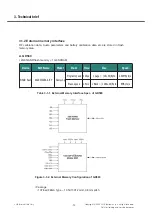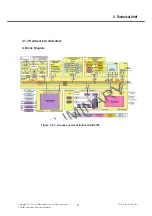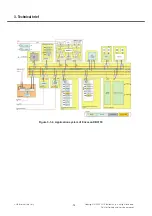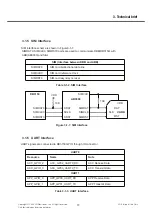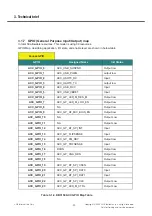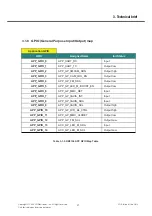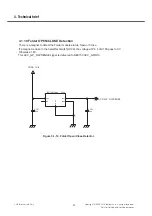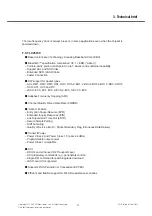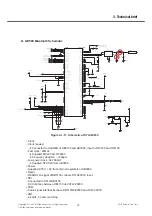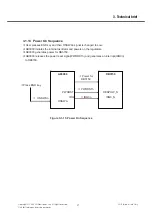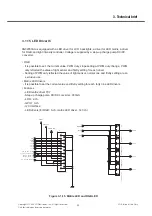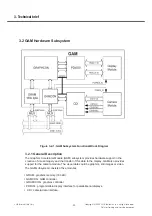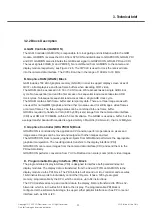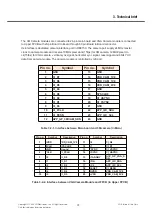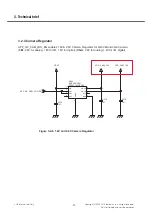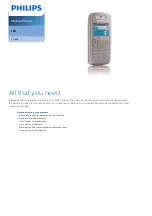
- 35 -
Copyright © 2009 LG Electronics. Inc. All right reserved.
Only for training and service purposes
LGE Internal Use Only
3. Technical brief
3.1.11 Bluetooth Interface
GD580 supports Bluetooth operation using ST’s STLC2593C Bluetooth module.
A. General Description
The Bluetooth interface utilizes the SPI interface for control signals going to and from the
Bluetooth module. The SPI is also used for data transmissions.
It uses the PCM interface for transmitting audio to and from the Bluetooth module.
The Bluetooth module uses both the 26 MHz master clock signal and the 32,768 kHz
low-frequency clock signal for internal timing within the Bluetooth module. The intention is
to use the low-frequency clock as a low-power timing provider and to use the 26 MHz as
a high precision timing reference used mainly by the Bluetooth radio during operation.
The clock request mechanism is used to minimize current consumption for the total system.
The intention is to use the CLKREQ signal to ask for the master clock when needed,
for example, when the Bluetooth radio is operating.
B. SPI Interface
The physical SPI interface is made up of 5 signals : clock, chip select, data in, data out and
interrupt. When the SPI mode is selected , these signals are available through the
BT_UART/BT_SPI and BT_HOST_WAKEUP pins.
The SPI interface is Master at the Host side, and Slave at the BT Controller side.
It is designed to work with the H4 and enhanced H4 protocol.
Also synchronous data packet transfer (sSCO) over HCI is supported.
The SPI data length and endianness are configurable.
The SPI interface can only operate in half duplex mode.
C. PCM Interface
The PCM interface is used to send audio to and from the Bluetooth module. The interface is a
synchronous interface using a PCM clock and a PCM sync signal for synchronization. Two data
signals are used for data, one in each direction.
The PCM clock signal operates at frequencies as high as 1 MHz. The word length of the audio
data can be 8 or 16 bits. Furthermore, the PCM interface has a function known as MP-PCM,
which is an addressing scheme, used to have more than two devices talking on the bus.
To add this function, the data pins have to be bi-directional. Additionally, the position of the
audio data relative to the frame sync pulse must be selectable. During the periods within a
frame that a device is not transmitting audio data, it must put both PCM data signals in a
high-impedance state to allow other devices access.
D. Master Clock and Clock Request Interface
The master clock (MCLK) is a 26 MHz signal used as the high precision clock signal for the
Bluetooth module. The signal can be switched on and off by the platform. The master clock
request (CLKREQ) is used by the Bluetooth module to ask for the master clock.
If the Bluetooth module asserts the signal high, it gets the master clock. The other
alternative for the Bluetooth module is to set the clock request output to high impedance
state, indicating that it does not need the master clock. The Bluetooth module receives the
master clock, if other parts of the chipset request it.
Содержание GD580
Страница 1: ...Service Manual Model GD580 Internal Use Only Service Manual GD580 Date November 2009 Issue 1 0 ...
Страница 179: ... 180 LGE Internal Use Only Copyright 2009 LG Electronics Inc All right reserved Only for training and service purposes ...
Страница 189: ... 190 LGE Internal Use Only Copyright 2009 LG Electronics Inc All right reserved Only for training and service purposes ...
Страница 203: ... 204 LGE Internal Use Only Copyright 2009 LG Electronics Inc All right reserved Only for training and service purposes ...
Страница 211: ... 212 LGE Internal Use Only Copyright 2009 LG Electronics Inc All right reserved Only for training and service purposes ...




